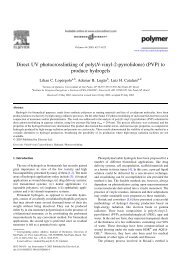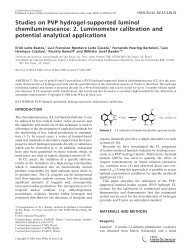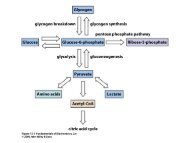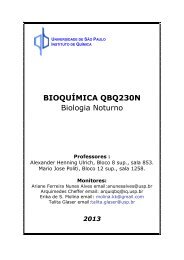The development of strategies for terpenoid structure determination
The development of strategies for terpenoid structure determination
The development of strategies for terpenoid structure determination
You also want an ePaper? Increase the reach of your titles
YUMPU automatically turns print PDFs into web optimized ePapers that Google loves.
version uses the high field 1 H NMR spectrum. A correlationwas established between the absolute stereochemistry <strong>of</strong> <strong>terpenoid</strong>secondary alcohols and the ∆δ (δ S δ R ) values <strong>of</strong> adjacentprotons <strong>for</strong> the (R)- and (S)-MPTA esters. This correlation wassuccessfully applied in establishing the absolute stereochemistry<strong>of</strong> a number <strong>of</strong> marine <strong>terpenoid</strong>s <strong>of</strong> the cembranolide andxenicane series. 98In a few instances the absolute configuration <strong>of</strong> a <strong>terpenoid</strong>has been determined by X-ray crystallography <strong>of</strong> a heavy atomderivative, e.g. an ester or an amide containing a bromine atom.<strong>The</strong> assumption is <strong>of</strong>ten made that all <strong>of</strong> a group <strong>of</strong> terpenesthat occur in a particular plant belong to the same enantiomericseries. However there have been a number <strong>of</strong> reports where,<strong>for</strong> example, enantiomeric labdane diterpenes co-occur in thewood <strong>of</strong> Oxystigma oxyphyllum 99 and in the leaves <strong>of</strong> Mimosahostilis. 100 Hence this assumption in <strong>terpenoid</strong> <strong>structure</strong>elucidaton is not always valid.15 <strong>The</strong> transition to spectroscopy driven <strong>strategies</strong><strong>The</strong> elucidation <strong>of</strong> the <strong>structure</strong> <strong>of</strong> gibberellic acid 54 representsthe transition between the <strong>strategies</strong> that were dominated bychemical degradation and those that were driven by the use <strong>of</strong>physical methods. <strong>The</strong> work in the 1950’s concentrated onestablishing the <strong>structure</strong> <strong>of</strong> the acid-catalysed degradation andrearrangement products, allogibberic 67 and gibberic 68 acids. 73<strong>The</strong>se studies utilized classical dehydrogenation reactions t<strong>of</strong>orm substituted fluorenes which were then synthesized, andsecondly stepwise degradative sequences in which rings C andD were cleaved. 101 This chemical work was supplemented byin<strong>for</strong>mation drawn from ultraviolet and infrared spectroscopy.However several aspects <strong>of</strong> the <strong>structure</strong> <strong>of</strong> gibberellic aciditself which were described in 1958, utilized assignments <strong>of</strong> the1 H NMR spectrum. 102 <strong>The</strong> full <strong>structure</strong> and stereochemistrywas based on a combination <strong>of</strong> chemical and spectroscopicstudies in which 1 H NMR spectroscopy played an importantrole in interrelating protons, <strong>for</strong> example the trans relationshipbetween H-5 and H-6. 103 Independent X-ray crystallographicstudies <strong>of</strong> heavy atom derivatives were also published.104 More recent studies on the <strong>structure</strong>s <strong>of</strong> novelgibberellins are entirely determined by physical methods,particularly mass spectrometry. 105Spectroscopic methods played a significant role in the finalelucidation <strong>of</strong> the <strong>structure</strong>s <strong>of</strong> a number <strong>of</strong> highly oxygenated<strong>terpenoid</strong> bitter principles including clerodin 69 106 andlimonin 70. 107 In these cases prior chemical work had establishedpartial <strong>structure</strong>s but the evidence <strong>for</strong> the full <strong>structure</strong>hinged on the ability <strong>of</strong> 1 H NMR spectroscopy to link groups<strong>of</strong> atoms. In the sesquiterpene area the elucidation and revision<strong>of</strong> the <strong>structure</strong> <strong>of</strong> the trichothecenes (e.g. 71) 108 revealedthe ability <strong>of</strong> 1 H NMR spin decoupling studies to cope withhighly oxygenated compounds, thus avoiding the need <strong>for</strong>the stepwise removal <strong>of</strong> functional groups and the structuralsimplification which characterized the earlier chemicallydriven <strong>strategies</strong>.<strong>The</strong> increasing role <strong>of</strong> X-ray crystallography in <strong>structure</strong><strong>determination</strong> was also illustrated at this time. A number <strong>of</strong><strong>structure</strong>s, such as those <strong>of</strong> clerodin 109 and limonin, 110 were alsodetermined by crystallographic methods in ‘competition’ withthe classical chemical and spectroscopic studies. Although thetheory <strong>of</strong> non-heavy atom <strong>structure</strong> <strong>determination</strong> was known,the majority <strong>of</strong> the <strong>terpenoid</strong> <strong>structure</strong>s that were reported inthe 1960’s were based on heavy atom derivatives. One <strong>of</strong> theearliest <strong>terpenoid</strong> non-heavy atom <strong>structure</strong>s to be reported 111was that <strong>of</strong> rosein III (11β-hydroxyrosenonolactone) 72 in1970.16 <strong>The</strong> impact <strong>of</strong> instrumental chromatographic techniques<strong>The</strong> <strong>development</strong> <strong>of</strong> instrumental chromatographic techniques<strong>for</strong> the separation <strong>of</strong> natural products, particularly <strong>terpenoid</strong>s,had widespread ramifications in <strong>structure</strong> elucidation. 112 <strong>The</strong>gas chromatographic analysis <strong>of</strong> essential oils had revealedtheir complexity and when coupled with mass spectrometry ledto the elucidation <strong>of</strong> the <strong>structure</strong>s <strong>of</strong> a number <strong>of</strong> new monoandsesqui<strong>terpenoid</strong>s. <strong>The</strong> understanding <strong>of</strong> factors whichaffect the fragmentation patterns <strong>of</strong> <strong>terpenoid</strong>s in the massspectrometer and the use <strong>of</strong> these as structural tools hasbecome very important. <strong>The</strong> sensitivity <strong>of</strong> the methods gave astimulus to insect chemistry in which a number <strong>of</strong> volatilemono- and sesqui<strong>terpenoid</strong>s play an important role as pheromones.113 <strong>The</strong> conversion <strong>of</strong> the gibberellin plant hormones totheir esters and trimethylsilyl ethers followed by their separationand identification by gas chromatography–mass spectrometryled not only to the elucidation <strong>of</strong> the <strong>structure</strong>s <strong>of</strong>over 120 <strong>of</strong> these compounds but also to their quantitation atvarious stages <strong>of</strong> plant <strong>development</strong>. 105,114 Confirmatory syntheticand model studies have become a very important part <strong>of</strong>these instrumental <strong>strategies</strong> in which very small amounts <strong>of</strong>the natural product are examined.<strong>The</strong> <strong>development</strong> <strong>of</strong> HPLC as a separation tool and the linkwith spectroscopic methods has had a similar impact on theisolation and <strong>structure</strong> elucidation <strong>of</strong> more polar <strong>terpenoid</strong>natural products, particularly compounds from marine sources.17 <strong>The</strong> impact <strong>of</strong> biosynthetic studies<strong>The</strong> <strong>development</strong> <strong>of</strong> plausible biogenetic schemes based on theisoprene rule, the cyclization <strong>of</strong> polyprenyl chains and therearrangement <strong>of</strong> carbocationic intermediates, provided themeans <strong>of</strong> evaluating <strong>terpenoid</strong> <strong>structure</strong>s. 115 <strong>The</strong> discovery <strong>of</strong>the role <strong>of</strong> mevalonic acid in the biosynthesis <strong>of</strong> cholesterol 116and the subsequent demonstration <strong>of</strong> its incorporationin vivo into <strong>terpenoid</strong> fungal metabolites led 117 to studies whichchanged this biogenetic speculation into biosynthetic evidence.Studies in <strong>terpenoid</strong> biosynthesis may be divided into fourphases. <strong>The</strong> first phase involves the origin <strong>of</strong> the isoprene unit,Nat. Prod. Rep., 2001, 18, 607–617 613





![PE]+ + N. Fragmentação por clivagem sigma](https://img.yumpu.com/50134385/1/180x260/pe-n-fragmentaaao-por-clivagem-sigma.jpg?quality=85)










